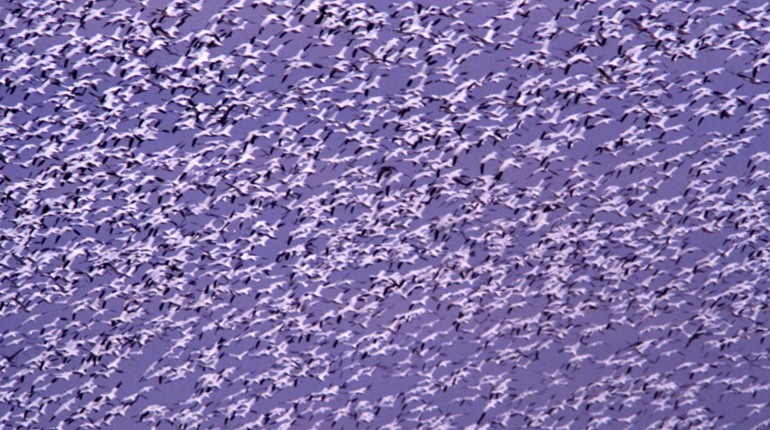
If you call waterfowl the same way my neighbor summons his dog—by repeating yourself progressively louder and longer whenever you’re being ignored—you’re apt to meet with considerable frustration. I consider this to be waterfowling’s biggest mistake. To avoid this error and get the best results from your duck and goose calls, try the following tips.
Shut Up and Watch
Sometimes the best calling you can do is none at all. Some days waterfowl are talkative; some days they’re not. Sometimes you’re exactly where they want to go; other days you’re not. If the day’s flight path has birds flying right toward you, let the first flock (or two) come over without calling. If they show no signs of dropping in, then call sparingly at first, and more urgently should they continue. Whenever you call, there’s always the chance you might say something the birds don’t like or you might draw attention to your blind.
If you’re off the flight path and a flock needs some encouragement to turn in your direction, back off the moment they do and watch. They’ll let you know if you should call again if they start veering off course. Most mornings you can gauge how much calling subsequent flocks will need by how the first few flocks respond.
Think Before Blowing
Whenever waterfowl call, they’re communicating something; they’re not making noise for the heck of it. Which is why you should never put a call to your lips before knowing what you want to say. Why are you about to call? Is it to attract their attention, to add realism to your spread, to turn around a departing flock? If there’s no clear reason why you’re about to call, you probably shouldn’t. If there is, match your call to the situation. If you need a comeback call to turn a departing mallard, quacks and feeding chuckles won’t suffice; however, a loud hail call will spook a nearby duck that only needed a few quacks to bring it all the way in to you. Calling isn’t just about making goosey or ducky noises; it’s about communicating the right message.
Learn to Read Body Language
The only way to tell if your calling is having any effect is to read the birds’ body language. Turning a flock of geese that’s heading to another field often depends on making a particular call or a series of sounds. Honking or clucking until you’re blue in the face might not do it. How can you tell? Because the geese are still flying straight and their wing beats haven’t varied one bit. At this point, you should add in a few moans. If the third goose from the end stops beating its wings for a second and tilts its back toward you … or the lead bird cranes its head, wobbles slightly and locks its wings … at least one goose likes the new notes. This tells you to make more of them. All you have to do is convince one goose to head your way and others will likely follow.
Less Can Be More
The main lesson in calling any game is to do as little as necessary. Sometimes that means calling excitedly and continuously, like on days when they’re migrating or when you’re hunting heavily pressured public land, where getting a flock’s attention, and keeping it, is paramount. Otherwise you should be calling just enough to draw attention to your decoys and to keep the birds coming. Your most excited calling should be held in reserve for when you really need it, like when a flock veers off course to go somewhere else. In such situations the greater the contrast—of going from a few low-key notes to excited chatter—the greater the effect will be. If you call loudly and aggressively all the time, how can you step up the excitement level when you need to regain a flock’s interest?
Timing Is Everything
Good calling isn’t sounding like a broken record; it’s making the right notes at precisely the right times. Once you know exactly when to call, you’ll need a lot less of it. When a duck is flying right at you and you call the instant you see it start to stray off course, you can usually bring it back in line with only a few notes. If you wait a few seconds you’ll really have your work cut out for you.
Circling flocks require similar precision. Ducks and geese normally land into the wind. If you call when they’re not in a position to bank into the decoys (when they’re upwind or crosswind), all you’re doing is drawing attention to your blind and reducing your call’s effectiveness. Wait until they’re on the downwind side of your spread and they can turn the instant you call.
If, however, they’re upwind and look like they’re about to go elsewhere, you’ll need to call right away to keep them circling, then lay off until they’re on the downwind side. Because timing is so critical, make sure you have a 360-degree view, or set up close enough to woods or a fence so the birds won’t circle behind you.
Play the Wind
Whenever flocks are approaching from an upwind or crosswind direction, calling them straight over you is a bad idea, as directly overhead offers them a vantage from which they can spot every flaw in your setup. Once you get their attention and they’re flying toward you, stop calling, or call sparingly, so they’ll drift well downwind, before calling them back. Like circling birds, they’ll now be in a position to turn sharply and coast right into your spread’s landing zone.
You’ll find that the stronger the wind, the farther downwind they should be before calling them back, since they’ll need more distance to drop altitude. Once you figure out how much distance the flocks will need to drop down, and how much calling they’ll need to finish up, you’ll start calling like an expert.





































